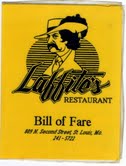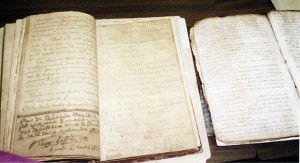Eerie Coincidences in Jean Laffite Research and Other Spooky Stories as Told by Pam Keyes
October 30, 2013 in American History, general history, History, Louisiana History
Pam Keyes is the Research Coordinator of the Laffite Society and a well known expert on the history of Jean Laffite and of the artifacts and written evidence that are available on the life of the famous privateer. In this interview we talked about some strange and eerie happenings surrounding her research.
Aya Katz: You have been researching Jean Laffite’s history nearly all your life. Have there been coincidences or eerie happenings that involved the research into the Laffite past?
Pam Keyes: There was the time I ran across Laffite’s Bar & Grill restaurant at St. Louis. I found that restaurant during the trip to St. Louis and Alton  to find the cemetery at Fosterburg where Jean laffite is said to be buried, so happening across that restaurant was very eerie. But it is just one of the strange things I’ve run across in Laffite studies, and I’m not the only one who has had such experiences. Jack Davis said before he started writing the Pirates Laffite book, when he was living in London for a year, he ran across a US Civil War themed restaurant that had a wall-size painting of Jean Laffite, along with paintings of Generals Butler and Sherman. Why the London.restaurant had placed Laffite in there was a total mystery. But one of the spookiest stories is the one about the attic windows in the convent of the Ursuline nuns.
to find the cemetery at Fosterburg where Jean laffite is said to be buried, so happening across that restaurant was very eerie. But it is just one of the strange things I’ve run across in Laffite studies, and I’m not the only one who has had such experiences. Jack Davis said before he started writing the Pirates Laffite book, when he was living in London for a year, he ran across a US Civil War themed restaurant that had a wall-size painting of Jean Laffite, along with paintings of Generals Butler and Sherman. Why the London.restaurant had placed Laffite in there was a total mystery. But one of the spookiest stories is the one about the attic windows in the convent of the Ursuline nuns.
Aya: Tell me the story of the attic windows.
Pam Keyes: This actually happened to me on a visit to New Orleans in November 2001. There was a legend I had heard about the casket girls, the young ladies who were brought over in the early 1700s to become brides of the plantation owners. When they first arrived in New Orleans, they stayed in the attic rooms, and some of these girls became sick and died before they ever got married. The legend is that a few of these girls haunted the Ursuline Convent and that they became vampires, preying at night on the tourists in the French Quarter. The legend was you could tell when the vampires were loose because the shutters of the attic windows of the Ursuline Convent would be open. On my visit to New Orleans, I went out alone one night around 9 p.m. when it was dark, with a full moon. My hotel was on Chartres, a couple of blocks away from the Ursuline Convent, which I had to walk by on my way to the St. Louis Cathedral as I planned to sit in the square and people watch. As I walked by the big convent building, I remembered the story about the casket girls/vampires, and checked out the dormer windows of the attic: the shutters weretightly together, as theyhad been earlier that day. I laughed to myself about the silly story and proceeded on to Jackson Square as planned. I sat down on a bench and watched the people walking by for about an hour, then decided I had better walk back to my hotel before it got too late and dangerous to be alone. At the corner of the Ursuline Convent, I stopped and looked up at the full moon, then over to the convent attic: the dormer shutters were all wide open! I made it back to the hotel in record time, and did not venture out in the dark again for the rest of the trip.
Aya Katz:What was the earliest eerie event that happened when you were researching the Laffite history?
Pam Keyes: Hmn, earliest eerie event would be a hard one to pick from. There was the time in the 1980s when I almost got killed by a lightning bolt in the French Quarter, that was pretty dramatic; but my favorite strange event was the time the Jean Laffite signed statement plopped into my lap at the New Orleans Public Library in 2003. But since you asked for earliest, it’s got to be the lightning story from the 1980s.
Aya Katz: What happened?
Pam Keyes:My then-husband and I were walking around looking at various shops in the French Quarter in one of those light misty rains that usually happens at least once a day in New Orleans because it is so close to the Gulf. I had brought my umbrella for both of us to use, and we were both under it as we walked down Chartres from Jackson Square (yes, Chartres again). We had just been to the Cabildo to look around and I was most vexed to not find anything whatsoever there on display regarding Laffite (the little portrait by Jarvis was in archival storage). There was a bookstore, the Librarie, in one of the old buildings that looked enticing, and my husband went inside the open door but I had to wait outside for a minute to take down my umbrella, had just done so, and barely had stepped onto the stoop when all at once there was a BOOM! as a bolt of lightning hit the cast iron lightpost about four feet from the door. My hair was all electrified, and there was a strong smell of ozone, but I wasn’t hurt. The shopkeeper and my husband were quite amazed, and the shopkeeper said in all his years of having that French Quarter bookstore, he’d never seen lightning hit a street light. Wish I could say I found a really rare book cheap there, to make the story neater, but alas I did not.
Aya Katz: That was a close call! Tell me about the Jean Laffite signature that just fell in your lap.
Pam Keyes: I had looked for some 35 years to no avail for a Jean Laffite signature for sale in autograph collections, etc., and had pretty much given up hope of ever finding one. All the known ones were in collections at federal archives and universities. The first one I actually got to touch had already been found by William C. Davis in the Notarial Archives, so when I went to New Orleans on a visit in late 2001, I looked at that one, and I realized there had to be a lot more around New Orleans somewhere. Since Davis already had combed the New Orleans area archives for Laffite items that were cataloged as such, I decided to strike out and look at some of the materials relating to the Laffite associates, like Vincent Gambie aka Jean Roux. I found a listing for two court cases involving him in the archives at the New Orleans Public Library, and requested the originals to view. Unlike the Notarial Archives, there was no close supervision at the city library special collections department, and I didn’t even have to wear gloves to handle the original documents, which were in plain manila folders. The librarian handed me the folder, then turned his back to me and went back to a different area of the stacks. I opened up the folder, and a folded slip of old paper fell out, into my lap. I retrieved it and opened it up, and got a shock as there before me was an authentic Jean Laffite signature on a July 1815 document. Jean had attested that some runaway slave had been working for Gambie on his ship at Barataria. I looked at the front of the folder, where the contents were listed: the statement signed by Laffite was not there. I looked back at the librarian, he was out of sight. I had found a previously unknown Laffite signature, and the way it was not archived, it could have easily been stolen. I took the paper over to the librarian in the back, and showed it to him, saying it hadn’t been noted on the folder and needed to be, because it was vulnerable to theft. The librarian to my disgust acted like it was no big deal. I had to wonder what else wasn’t properly archived there. Hurricane Katrina destroyed a lot of these documents in 2005, so it probably was lost then, but I still have a copy of the whole court case, including the signature.
Aya Katz: Do you have any other spooky stories?
Pam Keyes:I do have another spooky story, but it’s more about Andrew Jackson than Laffite. My ex-husband was from Mississippi, and we often went there to visit on vacation. One of my favorite places was Natchez. On one visit, we went on a trip to see the plantation houses up and down the Mississippi from Natchez, and because I was especially interested in one sort of off the regular tourist trail, we went to see Springfield Plantation, where Andrew Jackson and Rachel Donelson got married and spent their honeymoon. Back in the early 1980s, the plantation was owned by a railroad company, and one of their employees was living there and serving as caretaker of the home, giving occasional tours of the house. The layout was the typical early plantation style first floor, with big main foyer and hall, and rooms off to each side of the hall. Many of the original furnishings remained, according to the caretaker, as he led us down the hall. He proceeded into one room that was painted a sunny yellow and boasted a big fireplace with a large mirror to one side, and I noted a pianoforte to my right as I walked into the room. The tour guide continued his spiel about the house, said the room we were in had served as the music room at the time the Jacksons were married there, and in the early 1800s, but no more, as there was no piano anymore. What! I thought, and quickly looked back to where I had seen the pianoforte. It was gone, and as the saying goes, the hair stood up on the back of my neck.

Recent Comments